When i was a senior in college, I took a work-study position in the Sculpture department so I could have twenty-four hour access to the studios, particularly the welding shop, where I was building my senior thesis, A Gifting Machine, from scrap metal. That project, along with other mechanical sculptures, got me thinking about building a miniature city out of scrap metal and old mechanical parts, with moving elements, little lights, maybe even a sewer system and smokestacks that spewed pollution. I also considered building a second city that used solar panels and living machines that recycled the waste.
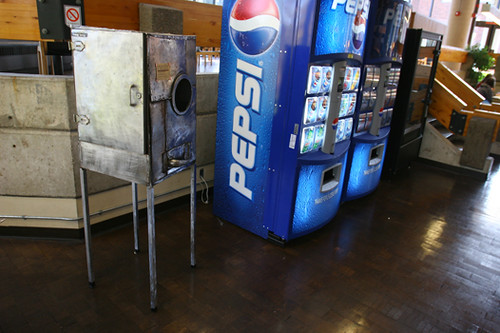

I went back to Montana that winter to visit my family, and while I was home, my mom gave me a sketchbook. On the firstpage, I drew a complicated city-scape, the begining to sketch out my ideas for the model city.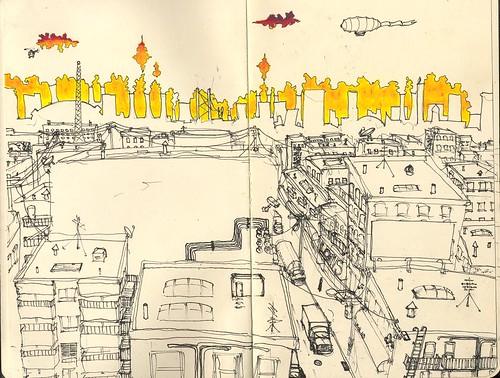
When I got back to Eugene, I was working with the Craft Center at the University of Oregon to set up a hot-glass studio. That's where I met Jason Harris, the owner of Jerome Baker Designs and the person hired to design and build the glass studios.
Jason saw my illustrations and designs and hired me to do some designs for his new skate company, Jerome Baker Decks. One of those designs was based on my city sketch, he wanted a city-scape skate deck, so I went to Portland and spent three days sketching the city before returning to Eugene to draw the deck.

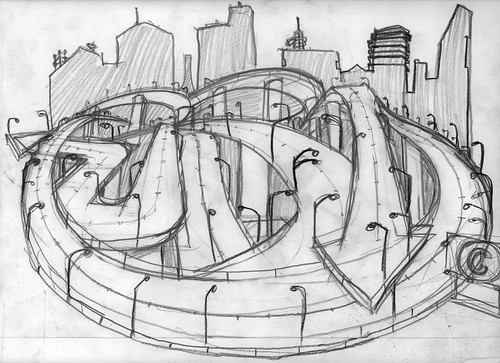

I had launched into a new exploration, without really becoming aware of it for quite some time. Most of the work I was doing at the time was exploring the shapes of cities, the way buildings come together and occupy space, the way roads intersect and the way that different elements like trees or fog broke up the lines of the city.


As I became aware of my studies I pushed them further and began exploring the quality of line that different elements of a city create. I moved to Portland that year, and began studying the jagged tree line that sat behind the tall, vertical, smooth lines of the buildings. I also focused on the long horizontal lines that bridges and roadways created, and the way that the fog would descend on the city, creating gradients against the hard lines of the city. I looked at the way the clouds would descend into the trees, making multiple layers of jagged lines appear where before there was only a smooth, deep greenish-black fading to blue in the distance with a single jagged line at the edge.
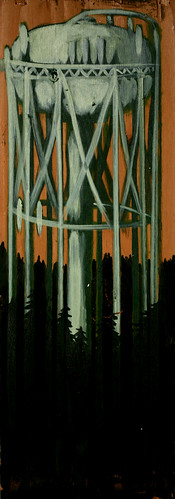
At this point I was diving deep into the shape and perspective of a city, learning and progressing and developing my own distinctive look. All the while, I was simultaneously looking for these same shapes and lines in nature, discovering them at the base of tree, in fallen logs in the woods, or in the way a river carves through a canyon. I was so focused on my studies, I was unaware of where they were taking me, and had almost completely forgotten how I'd arrived there.

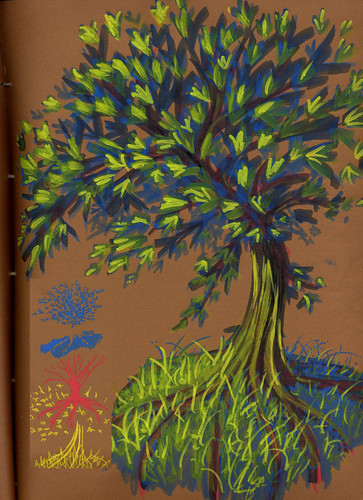
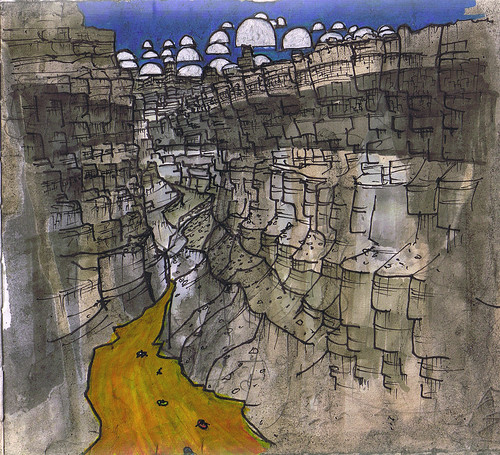
Just about the time I was becoming bored with my linear studies, and turning my attention from the shapes and lines toward color and light, I went to Burning Man again for the fourth time and saw something incredibly inspirational.
I was walking home one night from across the playa, strolling along the Esplanade for the first time that week, looking at the different theme camps set up along Black Rock City's principle boulevard.
One of the camps I passed was quite, this must have been their night out, but they left their stage illuminated for passerbys. The stage was a simple design, a translucent backdrop with lights behind projected through a cardboard cut-out to create a beautiful shadow of a forest, with grass, mushrooms, flowers and some trees. It was amazing for its elegance and simplicity, by no means the first of its kind, but it was the first time I'd really noticed the technique.
I rode home from Burning Man with two friends from Portland, who also happened to be two of the principle organizers for the Portland Burning Man Decompression. One of them, Shira, was planning the artwork for the event, and along the two day trip we talked a lot about the possibilities. I brought up the stage that had inspired me, and mentioned that I'd like to try something similar with a city skyline.
Back in Portland, I wrote the idea up and did a concept sketch, sending it off to Shira as a proposal, but also sending it to the Rebuilding Center, a construction materials re-use center near my house.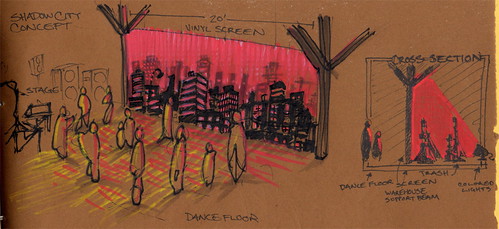
One afternoon I was hanging out looking through the Rebuilding center's piles of cool scraps and parts, and I noticed a ray of evening sun cutting through an upper window and casting a glowing circle on the wall a few feet off the floor. I began setting objects that I picked out in front of the ray of light, and looking at the different shadows they cast. That was when I noticed that three dimensional objects cast much more interesting and dynamic shadows than cardboard cut-outs; when you move a three dimensional object in the light, the shadow changes shape and perspective, unlike two-dimensional objects that only change perspective.
I pitched my idea to the Rebuilding Center, and told them a bit about the Decompression Party. The Rebuilding Center provided a lot of materials for free to an Burning Man art installation I worked on with Shrine and Tuk Tuk, the Tasseograph Tea Temple.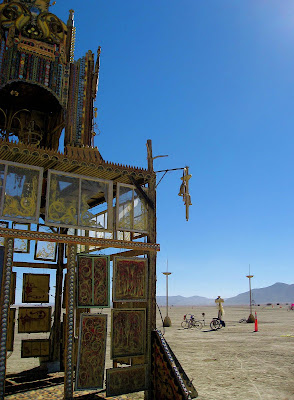
The Tea temple was also being set up at the Decompression, so it occurred to me the Rebuilding Center might donate materials for my city scape. They were into the idea, and they let me go through the Rebuilding Center and pick out materials that I thought would work.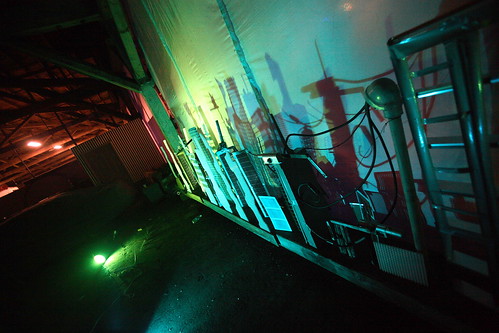
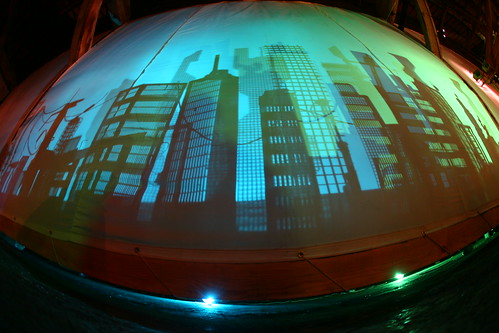
I installed the Shadow City at the Portland Decompression and it was a huge hit. I used a twenty foot timber that was lying around the warehouse where we hosted the event, and several lights that I brought down myself. during the event, I would go behind the screen and move the lights, swooping them through the city and changing the perspective and shape of the shadow cast on the screen.
After the party, I packed up the city onto a palette and left it at the warehouse. I began looking for other opportunities to install the city, and came across the Regional Arts and Culture Council's call for submissions for the Portland Building Exhibit space. I looked into the requirements and specifics and the space was a perfect match for the shadow city. I put together a proposal, using photos from the Decompression, and submitted it in December.
Last weekend, the RACC notified me that the Shadow City was selected and scheduled to be installed November 10th through December 5th in the lobby of the Portland Building in downtown Portland, home of the famous Portlandia sculpture and many of the City of Portland's offices.
So now I have 11 months to build the Shadow City. I already have most of the materials I need from the Rebuilding center's first donation, but I will also be looking for other grants to provide matching funding or donations. I'd like to incorporate some of my original ideas, from back in the Sculpture department at the University of Oregon. I'd like to get some mechanics, perhaps electrical, or potentially pneumatic, and I'd like to look into moving lighting systems, like the kinds that green houses use.
The Growth of the Shadow City
some fun words to whisper
If you say these kind of quite and stress the consonants, they make a nice rhythm:
do you cook zit, hut doo cook zit, dew tu-tu cooks it, hmm shit cooks it.
got two check accounts, got two check accounts, got two check accounts today.
fish are all caught so lets go home
forget your check accounts and take out two loans
bupity birds to catch the boots n pants to tame the choo-choo train .
Subscribe to:
Comments (Atom)
